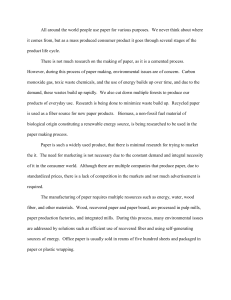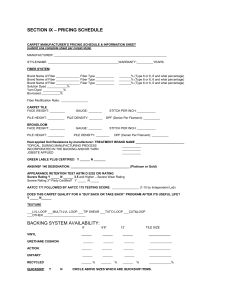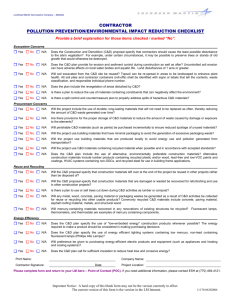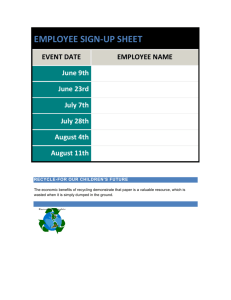Section 8 Packaging JC Action Items from 12- 9
advertisement
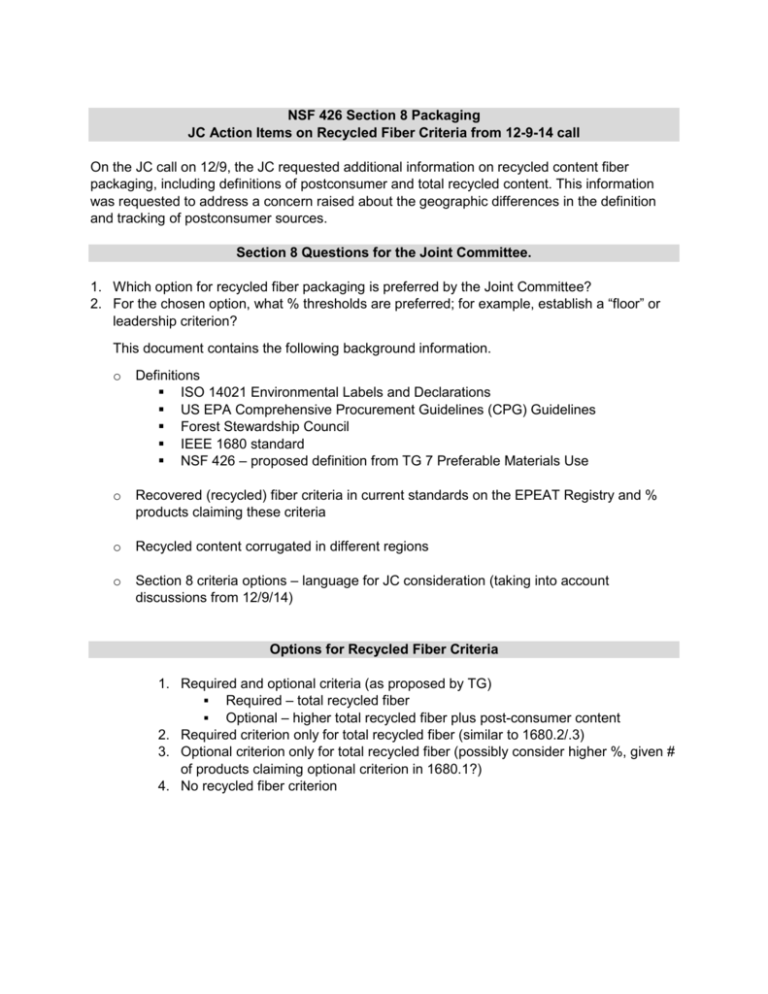
NSF 426 Section 8 Packaging JC Action Items on Recycled Fiber Criteria from 12-9-14 call On the JC call on 12/9, the JC requested additional information on recycled content fiber packaging, including definitions of postconsumer and total recycled content. This information was requested to address a concern raised about the geographic differences in the definition and tracking of postconsumer sources. Section 8 Questions for the Joint Committee. 1. Which option for recycled fiber packaging is preferred by the Joint Committee? 2. For the chosen option, what % thresholds are preferred; for example, establish a “floor” or leadership criterion? This document contains the following background information. o Definitions ISO 14021 Environmental Labels and Declarations US EPA Comprehensive Procurement Guidelines (CPG) Guidelines Forest Stewardship Council IEEE 1680 standard NSF 426 – proposed definition from TG 7 Preferable Materials Use o Recovered (recycled) fiber criteria in current standards on the EPEAT Registry and % products claiming these criteria o Recycled content corrugated in different regions o Section 8 criteria options – language for JC consideration (taking into account discussions from 12/9/14) Options for Recycled Fiber Criteria 1. Required and optional criteria (as proposed by TG) Required – total recycled fiber Optional – higher total recycled fiber plus post-consumer content 2. Required criterion only for total recycled fiber (similar to 1680.2/.3) 3. Optional criterion only for total recycled fiber (possibly consider higher %, given # of products claiming optional criterion in 1680.1?) 4. No recycled fiber criterion Definitions In summary: 1) The definitions of post-consumer in ISO and EPA differ around the return of material within distribution chain. A good illustration of the difference is provided by the “The Paper Lifecycle” a project of GreenBlue at http://thepaperlifecycle.org/recovery/indepth/recovered-and-recycled-paper-fiber-types-defined/. Both ISO and EPA exclude material recycled within the same manufacturing plant. “The International Organization for Standardization (ISO) considers magazines that reach the newsstand, are not sold, and are used again for recycled paper to be post-consumer material. According to the U.S. Environmental Protection Agency (EPA), magazines that reach the newsstand, are not sold, and are used again for recycled paper are considered pre-consumer material.” 2) The Forestry Stewardship Council (FSC) Reclaimed Materials Sourcing standard used for supply chain certification allows both post-consumer and pre-consumer sources to receive “reclaimed” status. 3) A brief article written by a paper industry representative provides a good, short explanation of the inconsistency among definitions, and suggests “percentage recycled content fiber” as a common term. http://www.environmentalleader.com/2011/09/20/defining-recycled-content-in-paperproducts/) This article sums up by saying: “Regardless of whether you are looking at ISO or EPA definitions, both post industrial and post consumer fiber falls in the category of recycled fiber content. So when making claims it is safest to simply state a certain percentage of recycled fiber. But if you want to be more specific about the type of fiber for making a claim (or when trying to understand a supplier’s claim) be sure to check the definitions and more specifically whether the definition in use is coming from the EPA or ISO. Definitions Note: green highlights emphasize point #1 above. That is, difference in post-consumer definitions between ISO & EPA and the common exclusion of plant waste in pre-consumer/postindustrial. 1) International Organization of Standardization (ISO) Recycled content is defined by ISO 14021 (from Recycled content: Proportion, by mass, of recycled material in a product or packaging. Only preconsumer and post-consumer materials shall be considered as recycled content, consistent with the following usage of the terms: o o Pre-consumer material: Material diverted from the waste stream during a manufacturing process. Excluded is reutilization of materials such as rework, regrind or scrap generated in a process and capable of being reclaimed within the same process that generated it. Post-consumer material: Material generated by households or by commercial, industrial and institutional facilities in their role as end-users of the product, which can no longer be used for its intended purpose. This includes returns of material from the distribution chain. 2) EPA Definitions from Comprehensive Procurement Guidelines See: http://www.epa.gov/epawaste/conserve/tools/cpg/products/define.htm Postconsumer fiber means: Paper, paperboard, and fibrous wastes from retail stores, office buildings, homes, and so forth, after they have passed through their end-usage as a consumer item, including: used corrugated boxes; old newspapers; old magazines; mixed waste paper; tabulating cards; and used cordage; and All paper, paperboard, and fibrous wastes that enter and are collected from municipal solid waste. Postconsumer fiber does not include fiber derived from printers' over-runs, converters' scrap, and over-issue publications. Recovered fiber means: Postconsumer fiber such as: Paper, paperboard, and fibrous materials from retail stores, office buildings, homes, and so forth, after they have passed through their end-usage as a consumer item, including: used corrugated boxes; old newspapers; old magazines; mixed waste paper; tabulating cards; and used cordage; and All paper, paperboard, and fibrous materials that enter and are collected from municipal solid waste, and Manufacturing wastes such as: Dry paper and paperboard waste generated after completion of the papermaking process (that is, those manufacturing operations up to and including the cutting and trimming of the paper machine reel into smaller rolls or rough sheets) including: envelope cuttings, bindery trimmings, and other paper and paperboard waste resulting from printing, cutting, forming, and other converting operations; bag, box, and carton manufacturing wastes; and butt rolls, mill wrappers, and rejected unused stock; and Repulped finished paper and paperboard from obsolete inventories of paper and paperboard manufacturers, merchants, wholesalers, dealers, printers, converters, or others. Mill broke means any paper waste generated in a paper mill prior to completion of the papermaking process. It is usually returned directly to the pulping process. Mill broke is excluded from the definition of "recovered fiber." 3) Forest Stewardship Council In its standard for Sourcing Reclaimed Materials in its Chain of Custody Program definitions of post-consumer and pre-consumer align with US EPA. A complete list of examples of pre & postconsumer can be found at: https://ic.fsc.org/reclaimedmaterial.93.htm Reclaimed material: Material that demonstrably would have otherwise been disposed of as waste or used for energy recovery, but has instead been collected and reclaimed as input material, in lieu of virgin material for re-use, recycling, re-milling in a manufacturing process or other commercial application. Inputs of the following material categories are classified as reclaimed materials: - FSC Recycled material Post-consumer reclaimed material Pre-consumer reclaimed material (FSC – STD-40-007 (V2-0) 4) IEEE 1680 Standards (appear to use EPA CPG definitions) postconsumer: A material or finished product that has served its intended use and has been discarded for disposal or recovery, having completed its life as a consumer item; part of the broader category of “recovered” items. recovered: Waste materials and by-products reclaimed or diverted from solid waste, not including those materials and by-products generated from, and commonly reused within, an original manufacturing process. recovered fiber: Postconsumer fiber such as paper, paperboard, and fibrous materials from retail stores, office buildings, homes, and so forth, after they have passed through their end-usage as a consumer item, including used corrugated boxes, old newspapers and magazines, mixed waste paper, tabulating cards, and used cordage; and all paper, paperboard, and fibrous materials that enter and are collected from municipal solid waste, and manufacturing wastes such as dry paper and paperboard waste generated after completion of the papermaking process (that is, those manufacturing operations up to and including the cutting and trimming of the paper machine reel into smaller rolls or rough sheets) including, envelope cuttings, bindery trimmings, and other paper and paperboard waste resulting from printing, cutting, forming, and other converting operations; bag, box, and carton manufacturing wastes; and butt rolls, mill wrappers, and rejected unused stock; and repulped finished paper and paperboard from obsolete inventories of paper and paperboard manufacturers, merchants, wholesalers, dealers, printers, converters, or others. Mill broke means any paper waste generated in a paper mill prior to completion of the papermaking process. It is usually returned directly to the pulping process. Mill broke is excluded from the definition of recovered fiber. 5) NSF 426 proposed by TG 7 on Preferable Material Use Postconsumer recycled material: Material generated by the end users of products that has fulfilled its intended purpose or can longer be used, this includes material returned from within the distribution chain. Current Standards on EPEAT Registry – Focus & Declared Products 1680.1 o Criterion 4.8.3.2 (Optional) Packaging shall meet or exceed minimum postconsumer content of CPG over the year using weighted average. Based on table above, the minimum postconsumer content: Corrugated 25% Folding cartons 40% o o Definitions postconsumer: A material or finished product that has served its intended use and has been discarded for disposal or recovery, having completed its life as a consumer item; part of the broader category of “recovered” items. recovered: Waste materials and by-products reclaimed or diverted from solid waste, not including those materials and by-products generated from, and commonly reused within, an original manufacturing process. Products on EPEAT Registry claiming optional point US China Taiwan Latvia Brazil 1680.2 & 1680.3 o Criterion 4.8.3.1 (Required) % of products declared to 4.8.3.2 93.6% (1487 of 1589 ) 95.5 % (405 of 424) 96.9 %(375 of 387) 96.3 % 336 of 349) 96.9% (345 of 356) Packaging materials meet or exceed the minimum total recovered fiber content specified. Give preference to post-consumer content. Corrugated Paperboard Total recovered fiber 25% 80% Recycled Content Fiber US (based on TG 8 research – multple sources) 47% recycled fiber (from old corrugated containers) is industry average for corrugated in US (http://www.fibrebox.org/upload/2009/WMT%20Packaging%20Material%20Brief%20Corrugate d%2011-2007%20final.pdf) At least 3 major packaging companies in US (Cascade, Rack10, SP Fiber Technology) offer 100% recycled content. Two breakpoints for post-consumer for cartons (with 100% total recycled): 35 % & 50-60 %. Cascade sold 100% recycled content with 40% PCR For corrugated the fluted part (~1/3 of box) is often PCR, since less sensitive to quality; therefore 30% PCR not unreasonable. Europe Source: FEFCO & CEPI ContainerBoard, 2012 European Database for Corrugated Board Life Cycle Studies; downloaded at http://www.fefco.org/sites/default/files/documents/LCA%20report%202012_0.pdf Taiwan One supplier offers 3 grades (which are listed on their MSDS); other suppliers in Taiwan & China are expected to be similar, according to one manufacturer. This manufacturer uses A & B2 for server products, but mostly B2. Using grades with less recycled content is more expensive. Post-consumer content is not differentiated. Grade Recycled Waste A 75-85% B2 80- 90% B4 100% Options for Recovered Fiber Criteria 1. Required and optional criteria (as proposed by TG) Required – total recycled fiber Optional – higher total recycled fiber plus post-consumer content 2. Required criterion only for total recycled fiber (similar to 1680.2/.3) 3. Optional criterion only for total recycled fiber (possibly consider higher %, given # of products claiming optional criterion in 1680.1?) 4. No recycled fiber criterion Option #1 – as proposed by the TG (with exclusion for alternatives per 12/9 discussion) Required + Optional 8.1.3 Total Recycled Fiber Content in Packaging TG Recommendation (Required) Fiber-based packaging materials shall contain the a minimum total percentage recycled content fiber content (by fiber weight) as specified shown in Table 8.1. In their packaging specifications, m Manufacturers shall give also state a preference in purchasing specifications for a minimum to the maximum 25 percent postconsumer recycled content fiber content (by fiber weight). Fiber-based content derived from alternative sources (such as bamboo or mushrooms) to traditional paper mill products are exempt from this recycled fiber requirement. “Not Applicable” may be declared on the Product Registry by manufacturer if the product packaging does not contain fiber-based packaging, or if fiber-based packaging is derived from exempt alternative sources. Table 8.1 Packaging Category Corrugated containers Percentage Total Recycled Content Fiber (by fiber weight) 50 All other fiber-based packaging 80 8.2.1 Higher Total Recycled Fiber and Post Consumer Content TG Recommendation (Optional) Fiber-based packaging materials shall contain a minimum percentage total and PCR recycled content fiber (by fiber weight) as specified in Table 8.2. Table 8.2 Packaging Category Percentage Total Recycled Content Fiber Percentage PCR Content Fiber (by fiber weight) (by fiber weight) Corrugated containers 80 35 All other fiber-based packaging 100 40 Manufacturer shall document of the source of post consumer recycled content to demonstrate that the fiber meets the definition of post consumer recycled content in this standard. “Not Applicable” may be declared on the Product Registry by manufacturer if the product packaging does not contain fiber-based packaging. This criterion may be declared differently in different countries or regions. Option #2 (Required) Required criterion from Option #1 only Option #3 (Optional) Optional criterion only with higher thresholds for recycled content; no PCR 8.2.1 Higher Total Recycled Fiber and Post Consumer Content TG Recommendation Fiber-based packaging materials shall contain a minimum percentage total recycled content fiber (by fiber weight) as specified in Table 8.2. Table 8.2 Packaging Category Percentage Total Recycled Content Fiber (by fiber weight) Corrugated containers 80 All other fiber-based packaging 100 “Not Applicable” may be declared on the Product Registry by manufacturer if the product packaging does not contain fiber-based packaging. This criterion may be declared differently in different countries or regions. Option #4 No recycled fiber criterion
